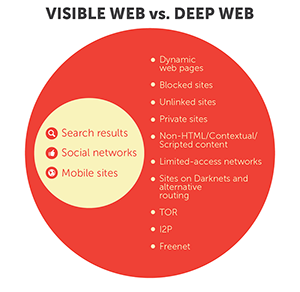From Tor to Ulbricht: The Deep Web Timeline
A 16-month trial unprecedented in magnitude in the history of global judicial systems culminated in a decision on Wednesday afternoon, leaving one Ross William Ulbricht guilty of seven charges that include money laundering and narcotics.
[Read: Ross Ulbricht: Silk Road creator convicted on drugs charges]
Ulbricht, also known as “Dread Pirate Roberts,” is the founder of the Silk Road online marketplace, now infamous for its drug and cybercrime exchanges. He faces a possible lifetime sentence for deals made in the space we all share but usually take for granted: cyberspace.
Visible Web versus the Deep Web
 Why is it that most people only heard of the Deep Web or how big the Silk Road is when Ulbricht got arrested? For one, the Deep Web is not a readily visible content source that anyone can just access.
Why is it that most people only heard of the Deep Web or how big the Silk Road is when Ulbricht got arrested? For one, the Deep Web is not a readily visible content source that anyone can just access.
Our daily online habits reside mostly on what we know as the visible web, which include sites and content that search crawlers can collect data from. Here are your search results, social media pages, mobile sites, games, and more.
It is believed that only an estimated 0.03% of the total content of the Internet are crawled by search engines.
Trend Micro researchers defined the term “deep web” as “a class of content on the Internet which, for different technical reasons, is not indexed by search engines.”
Strictly speaking, content hosted in the deep web are hidden, untraceable, and anonymous. Recently, the movie BlackHat highlighted these defining characteristics of the deep web by mentioning the Onion Router (Tor) as a means for the hackers to hide their location.
[Read: Silk Road and the Pitfalls of the Anonymous Internet]
Note, however that many mistakenly equate the deep web to refer only to the Onion Router (Tor) network. This is highly inaccurate given as Tor is only one of three renowned darknets—networks that offer anonymity for web content—the two others being I2P and Freenet. The deep web is also filled with sites and content hosted on alternative top-level domains or “rogue TLDs” not visible to most of us.
A Timeline of the Deep Web
In the graphic below, we highlight the significant events that define the deep web and what transpires as a consequence of anonymity:
“The recent shutdown of the Silk Road marketplace is a big blow to the underground trade of illegal items. However, the deep web has the potential to host an increasingly high number of malicious services and activities and, unfortunately, it will not be long before new large marketplaces emerge. As such, security researchers have to remain vigilant and find new ways to spot upcoming malicious services to deal with new phenomena the moment they appear,” as concluded by Trend Micro forward-looking threat researchers in the research paper, Deep Web, It’s Not All About Tor.
Visit the Deep Web section of the Threat Intelligence Center for more on the Deep Web and the Cybercriminal Underground
Like it? Add this infographic to your site:
1. Click on the box below. 2. Press Ctrl+A to select all. 3. Press Ctrl+C to copy. 4. Paste the code into your page (Ctrl+V).
Image will appear the same size as you see above.
последний
- Unveiling AI Agent Vulnerabilities Part I: Introduction to AI Agent Vulnerabilities
- The Ever-Evolving Threat of the Russian-Speaking Cybercriminal Underground
- From Registries to Private Networks: Threat Scenarios Putting Organizations in Jeopardy
- Trend 2025 Cyber Risk Report
- The Future of Social Engineering

 Cellular IoT Vulnerabilities: Another Door to Cellular Networks
Cellular IoT Vulnerabilities: Another Door to Cellular Networks AI in the Crosshairs: Understanding and Detecting Attacks on AWS AI Services with Trend Vision One™
AI in the Crosshairs: Understanding and Detecting Attacks on AWS AI Services with Trend Vision One™ Trend 2025 Cyber Risk Report
Trend 2025 Cyber Risk Report CES 2025: A Comprehensive Look at AI Digital Assistants and Their Security Risks
CES 2025: A Comprehensive Look at AI Digital Assistants and Their Security Risks